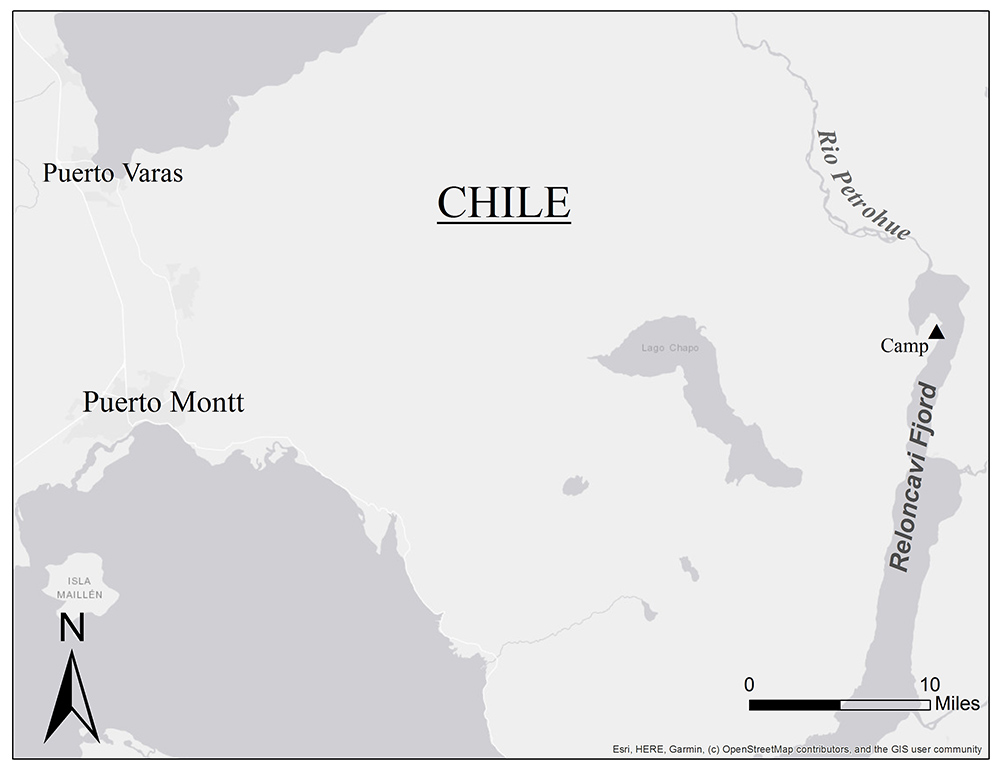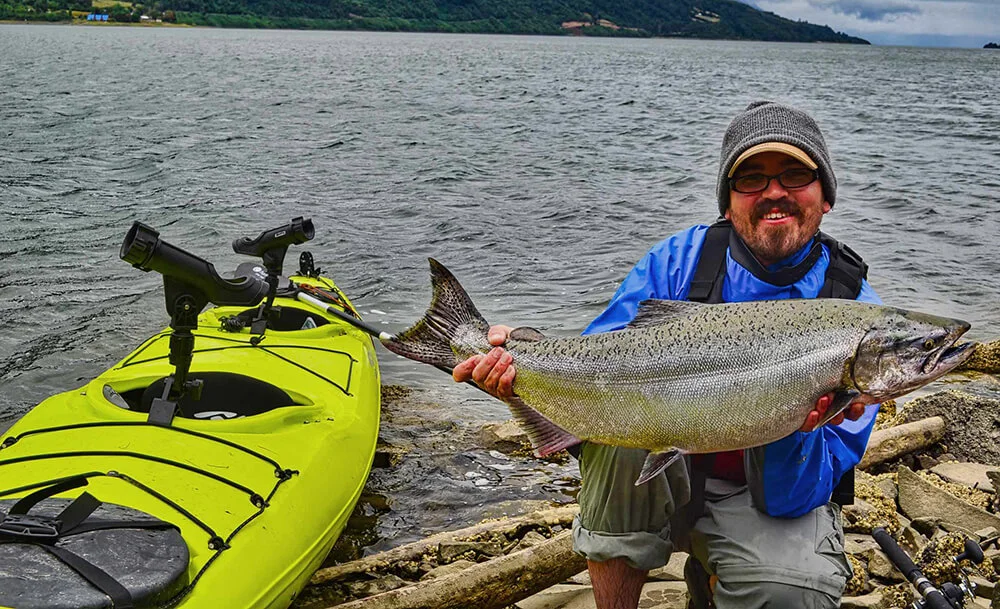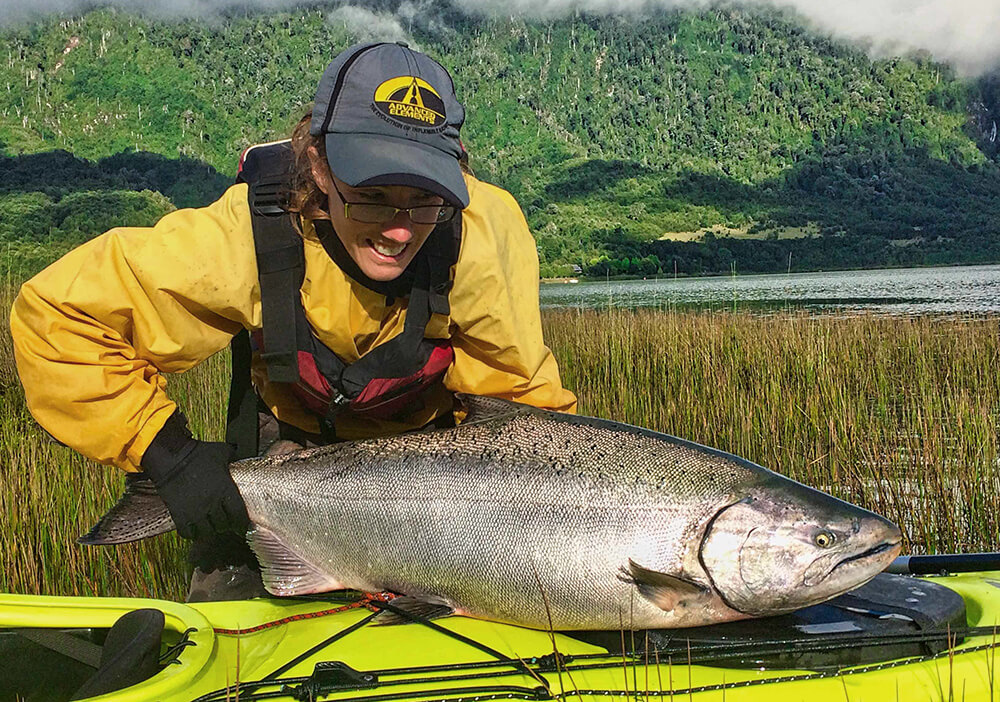Tandem Kayak Fishing Patagonia's King Salmon
By: Tyler Hicks
We were making no headway as powerful winds ripped down from the Andes Mountains and across the fjord. In the front of our tandem kayak, Sidra turned to me with nothing but defeat written on her face. We were no match for the 30 mph winds and the powerful tides of the Reloncavi fjord; the forces of nature were turning against us and more so with each passing minute. It was hopeless. Our arms were on fire. We would not reach the mouth of the Petrohue River and the best fishing grounds. Our only full day of fishing for Patagonia's legendary if not mythical King Salmon was squandered by a powerful storm system that was sweeping across the region.
Reluctantly we turned back south. With the wind and tides in our favor, we were on the move again. We redeployed our fishing gear, opting to hug the shoreline that offered some protection from the 3' wind waves that churned the fjordlands dark waters. We only had two miles to paddle back to the camp. I closely monitored the $40 fish finder's depth reading pinging the bottom to ensure our trolling gear didn't snag. As we rounded a point, our camp came into view, and suddenly a large reef rose from the bottom. The depth reading jumped from 100' to 20,' and I glanced nervously at the rod tip. Suddenly the rod loaded up, and for a split second, I was sure we had snagged the bottom. Then suddenly the rod exploded into life, line screamed from the reel, and I turned to see the unmistakable sight of a large purple, chrome, and black tail thrashing the angry surface of the fjordland's waters.

This story actually begins before I was born. In the 1970s, there were many efforts, spanning decades, to establish non-native salmon runs in Chilean Patagonia. Many, if not most, of these attempts, failed. Introductions of Chinook Salmon, also known as King Salmon, were made across the region with stock originating from Washington, British Columbia, and New Zealand. During the same period, salmon farming and aquaculture grew into one of the largest and most powerful industries in the region.
Meanwhile, King Salmon were quietly establishing a foothold in the region's many pristine rivers. With the focus on the region's salmon farming and not the harvest of "wild" or feral salmon, the King Salmon of Patagonia were free of any significant fishing pressures from commercial and recreational fleets. Early in the 21st century, anglers pursuing the region's famous trout fisheries began encountering huge spawning King Salmon in the upper reaches of Patagonia's rivers. Fish in the 50 to 60 lb range were not uncommon. Patagonia was the new frontier for giant salmon, but much remained mysterious about these fish.
Fast forward to 2016. I had always wanted to visit Patagonia; the scenery, the wildlife, and the fishing had me enthralled from a young age. With only a few months of planning, my wife and I decided to embark on a two-week self-guided tour of northern Patagonia. Priority on the target list was to try and catch an Austral King Salmon from a kayak. Internet sleuthing revealed little about the region's salmon fishing, but scientific publications were more enlightening. It seemed that King Salmon were present in several rivers near our port of entry city, Puerto Montt. The timing of salmon runs mimicked those of "spring Kings" in the Pacific Northwest, with fish pushing into rivers in February thru May. We intended to target fish in the brackish waters at these rivers' mouths, where we hoped they would be staging. Early February seemed to make the most sense in terms of timing, but it was all a guessing game at this point.

Eventually, we settled on the mouth of the Rio Petrohue. Tidal swings in the fjordlands are massive, often exceeding 20', but there was a period of relatively weak 7' exchanges late in our trip. We were able to secure the rental of a Looksha 17T tandem kayak from Ko'kayak in nearby Puerto Varas. Additionally, through that kayak shop, we were able to secure a campsite on a small farm directly on the fjord just miles from the mouth of the Rio Petrohue. The next few months were spent planning how to outfit a kayak for King Salmon trolling without drilling any holes. Clamp-on Scotty rod holders would hold the rods while we paddled, and for salmon fishing, I used that same gear I use to target them on my home waters of the Columbia River, which included: Yakima Bait's "Big Al's" fish flashers, Brad's Superbait cut plugs, and lead cannonballs to get them down to depth. A cheap battery-powered fishfinder would at least give us depth. I somehow snuck two 8' two-piece Shimano TDR glass trolling rods onto the airplane that would be outfitted with two line-counter reels spooled with 65-lb braid. We were set, all except for a landing net, of course.
Patagonia was everything we dreamed it would be, and for the first week and a half, we enjoyed backpacking into some of the most beautiful areas on planet Earth. We found streams full of fat and colorful Brook and Rainbow Trout, all eager to take a fly. The time finally came to begin our King Salmon kayak adventure. Stopping at a small tackle shop, we procured a sizeable folding landing net. We arrived early at the kayak shop on the shores of Llago Llanquihue watched over by the massive and breathtaking glacier-capped Osorno Volcano. The shop's owner pulled up in a paintless and heavily pitted Subaru Outback. I commented on how it looked as if it had been driven through a blast furnace, to which he informed me that it had been buried in hot ash and pumice from a volcanic eruption a few years prior. We loaded the chartreuse kayak onto the Subaru and made the 30-minute drive to the fjord. We agreed to meet back at the same place in two days. "Don't scratch the kayak and don't die." was all the advice he gave us before his pumice pummeled Subaru disappeared in a cloud of volcanic dust.
We loaded all our camping gear on the kayaks and shoved off for the short 3-mile paddle to our campsite. It was late afternoon, bluebird skies, and dead calm winds. Along the way, we saw several King Salmon rolling at the mouth of the Rio Petrohue, which only built anticipation for the next day. We arrived at our campsite and were greeted by our host, an elderly widow who lived on her small subsistence farm accessible only by a wooden rowboat. She and her visiting son seemed very skeptical of our intention to catch a King Salmon from the kayak. Sidra set up camp while I rigged the rods and kayak for fishing in the failing light.
Around midnight I awoke to wind and rain thrashing the tent. I hoped the weather would improve as dawn approached, but as daylight broke, the winds only intensified. I planned to ride the incoming tides to the best fishing grounds, fish the slack, and return to camp on the outgoing. With 30 mph winds ripping across the fjord, we opted to stay on shore huddled in an old barn along the shoreline, sipping tea and coffee. After several hours the wind tempered ever so slightly, and we decided to make a go of it. As we pushed off, the wind immediately grabbed the bow and spun us opposite of where we needed to go. Finally, we nosed around and found shelter in a small cove to our north where we successfully deployed our gear 20-30' below us using 8-10 oz lead cannonballs. We immediately began catching small resident King Salmon in the 2 to 5 lb range. Sidra hooked a large Chilean Sandperch, which made for an entertaining, "What the hell is that?" discussion. However, our delayed start meant that we were now fighting the outgoing tide and the northerly winds. It was a lost cause. We would not be able to reach the areas we had seen King Salmon rolling the day before. Fatigued, drenched by the driving rain, and cold, we turned back for camp.
I plucked the rod from the rod holder. Line screamed from the reel while the salmon thrashed on the surface some 40' behind the kayak. The kayak whipped around sideways as wind waves rocked the kayak back and forth violently. I managed to move the net forward just as Sidra had stowed away her gear. I trust very few people to net a fish for me, and she is one of them. The kayak was in a slow spin forced by wind and the drag of the fish that seemed determined to occupy the space just off the kayak's stern. With a little rudder work, I was able to bring the fish to the bow, where Sidra timed a perfect stab of the net. Joy and relief washed over me as I gazed upon a dream realized. We had landed a big Austral King Salmon.

Conveniently the wind and the battle had carried us directly in front of our camp. We landed the kayak and decided to gift the fish to our hosts. My arms burned as I carried the 20+ lb salmon through several pastures up the hill, passing herds of sheep and trailed by curious hogs. The wind was still blowing with horizontal rain when the door of the humble cottage swung open. In my broken Spanish, I explained it was a gift for her. The woman's face lit up, and she rushed out in the rain and wind, hugging and kissing Sidra and I, seemingly unfazed by the fact we were soaking wet and covered in fish slime. She invited us back that evening to celebrate.
Energized by our catch, we tried to fish for a few more hours but failed to find any willing biters. We returned to camp soaked and chilled to the bone as the sun started to slip behind the mountains. At the cottage, we were greeted with hugs and a freshly stoked fire in the stove. We slipped our wet sandals under the stove to dry and warmed ourselves by the fire. Our host brought out a giant bottle of red wine to celebrate the salmon. We told fishing stories, talked about life on her farm, life at home in the Pacific Northwest, she tried to teach Sidra how to make yarn from wool she had freshly sheered, and we all got a little tipsy together. It was an experience I won't soon forget.
The storm passed in the night, and in the morning, we were greeted with blue skies and glassy water. We had five hours before we needed to return to camp and use favorable tides to carry us back to the launch. We struck north to the mouth of the Rio Petrohue at dawn and, with the tide in our favor, made quick progress. We marked several fish on the fishfinder but found no willing biters. Sidra suggested we try trolling along the shelf of the estuary, where it drops into the deep waters of the fjord. Just as we arrived on the depth break, a large King Salmon rolled adjacent to the kayak. I hooked and landed a large flatfish, and we continued to zig-zag back and forth across the depth break. Suddenly Sidra's rod sprung to life, and immediately line began peeling off the reel. The fish turned and ran for deep water and kept her guessing, changing directions multiple times, forcing her to work the rod tip around the bow several times.
With no current or wind, this fish was much less of a struggle than the previous day's experience. After one big final run at the kayak, Sidra finally won the battle, and I netted her first big Chilean King. This fish was significantly bigger than my fish from the day before and carried an impressive girth. We estimated it weighed in the mid-'30s. Sidra and the fish both spent a few minutes recovering together before parting ways.

The outgoing tide was now in full swing, and despite a few more hours trolling, we only managed to connect with a few small resident Kings. We turned back for camp as the current picked up. We cruised at nearly five mph with minimal paddling, and the bottom suddenly rose from 60' to 15'. We quickly reeled up to 20' on the line counters when Sidra's rod went heavy. Snagged? Those thoughts were quickly dispelled when her line began moving perpendicular to the kayak and started dragging the kayak against the current.
Sidra read out audibles from the line counter as the drag system did its job: 50', 100', 150', until finally, the fish stopped at 180'. At the end of the mind-blowing run, a massive salmon could be seen jumping out on the bay, sharking across the surface, as the flasher skipped along in its wake. It seemed miles away, and I knew Sidra was in for a long fight. Each successive run was shorter and shorter. The current carried us into a large eddy that worked in our favor drawing the fish towards us and pushing us near shore. The fish had left everything on the table on its initial run, and by the time it reached the kayak netting, it was uneventful.
The fish was massive. Measuring well over 40", it carried enormous girth. It took both of my hands to wrap around the base of the tail. We estimated the weight to be in the upper 40's perhaps nudging 50 lbs. Sidra, exhausted from the fight, could not even muster the strength to lift the fish. We snapped a few photos and returned the fish to the water as it was eager to continue on its journey. The giant fish slipped from Sidra's grip with its massive tail fin collapsing and sliding thru her still clenched hands, not quite ready to see the fish go. Silently the enormous fish disappeared into the blue-green waters of the fjord.

We would pay dearly for the delay in our return to camp. The south winds had come up as we rounded the corner, and massive super eddies were forming in the fjord as the outgoing tide peaked. At one moment, we would be fighting head currents, and the next moment they would be pushing us along. We struggled against wind and current before we finally made it to just offshore our camp. We pulled our gear one last time from the water and beached the kayak. We collapsed camp, snarfed down lunch, hugged and kissed our host goodbye, and packed the kayak full to the brim. The tide had again shifted, and the wind would be to our back. It was a leisurely paddle back to launch where our vehicle was waiting for us. As the Reloncavi Fjord's blue waters faded in the side view mirrors, I smiled, knowing that we had realized a dream. I also smiled because I knew I would return...someday.






